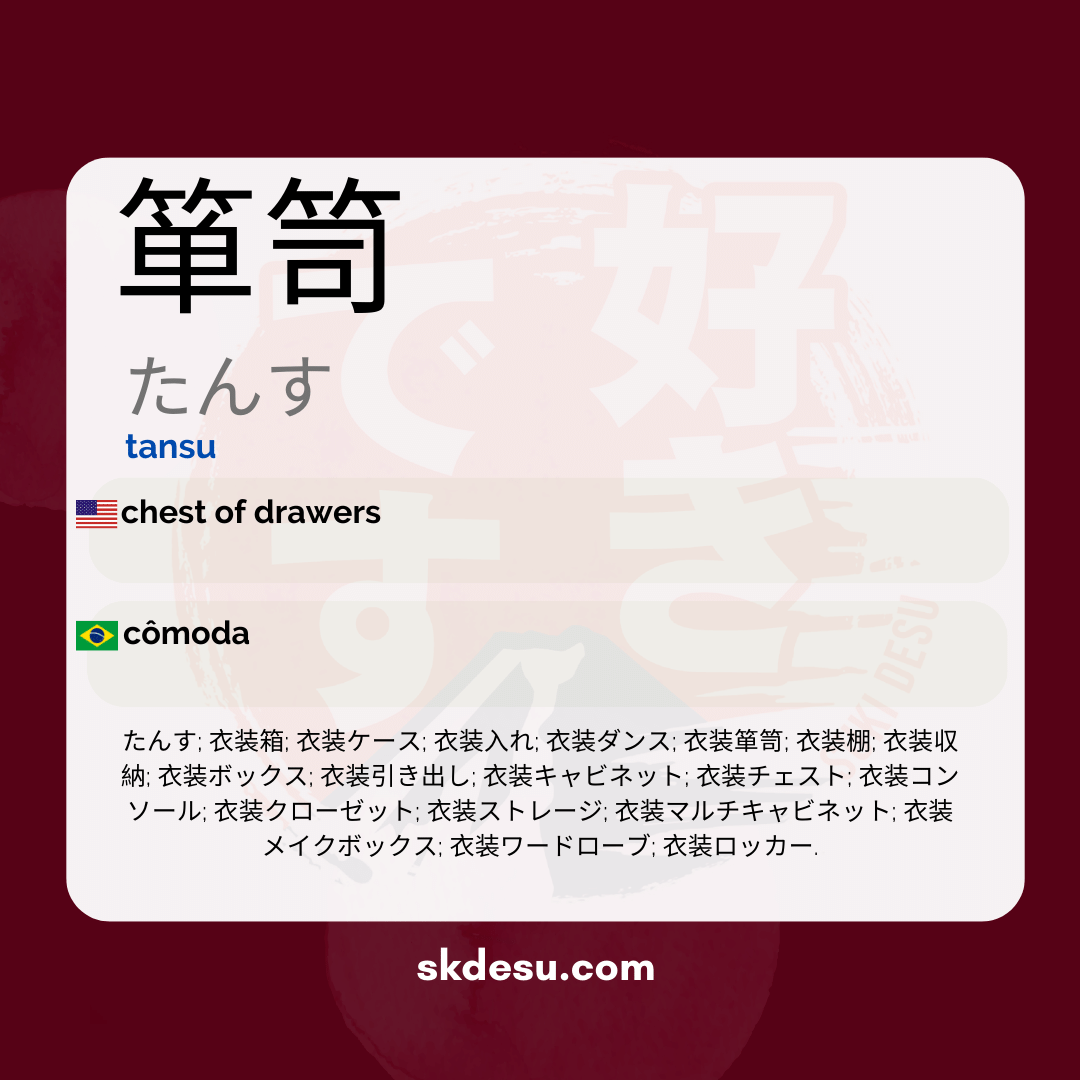Translation and Meaning of: 箪笥 - tansu
If you are studying Japanese or are curious about Japanese culture, you may have come across the word 箪笥 (たんす - tansu). This term, which may seem simple at first glance, carries an interesting historical and cultural richness. In this article, we will explore the meaning, origin, and usage of this word in everyday Japanese, as well as some curiosities that will help you memorize it more easily.
Suki Nihongo, the best online Japanese dictionary, provides detailed information about terms like 箪笥, which refers to a traditional piece of furniture in Japan. But is this word used frequently nowadays? How do the Japanese use it in everyday sentences? Let's uncover all of this below, clearly and directly.
What does 箪笥 (たんす) mean?
箪笥 (tansu) is a Japanese word that refers to a type of traditional chest or cabinet, typically made of wood. This piece of furniture was very common in ancient Japan for storing clothes, personal belongings, and even important documents. Unlike Western wardrobes, tansu often feature drawers and sliding doors, alongside a design that combines functionality and aesthetics.
Although the use of tansu has decreased with the modernization of Japanese houses, it remains a symbol of tradition and craftsmanship. Many families preserve these furniture pieces as family heirlooms, and some old models are considered true works of art. If you visit a more traditional house in Japan, especially in rural areas, you may still find a well-preserved tansu.
The origin and history of tansu
The word 箪笥 has an interesting etymology. The first kanji, 箪, originally referred to a type of bamboo basket used to store rice or other food. The second kanji, 笥, is also related to storage containers. Together, these characters form the idea of a piece of furniture designed to hold belongings, evolving into the current meaning of cabinet or chest.
The tansu emerged during the Edo period (1603-1868), when trade and urban life expanded in Japan. As people accumulated more possessions, the need for storage furniture grew. Craftsmen began to produce tansu using durable woods, such as cedar and cypress, often decorated with ornamental hardware. Some models were even designed to be easily transported in case of fire, a common risk in the cities of that time.
How do the Japanese use the word tansu today?
In today’s world, tansu is still a recognized word, but its use is more associated with old or traditional style furniture. In modern homes, Japanese people generally use terms like クローゼット (kuroozetto - closet) or ワードローブ (waadoroobu - wardrobe) to refer to contemporary cabinets. However, in antique shops or discussions about traditional decoration, tansu remains the correct term.
One curiosity is that some restaurants and inns in Japan use old tansus as part of the decoration, creating a nostalgic atmosphere. Additionally, in animes and period dramas, it's common to see characters opening tansu drawers to retrieve kimonos or important documents. These appearances help keep the word alive in popular culture, even though its everyday use has diminished.
Tips for memorizing the word 箪笥
If you want to remember this word in your vocabulary, a good tip is to associate the kanjis with their original meaning. Keep in mind that both characters relate to "store" or "save," which makes perfect sense for a piece of furniture like the tansu. Another strategy is to think of scenes from movies or animes where wooden cabinets with drawers appear - they are probably tansus.
To practice, how about trying to create a simple sentence? For example: たんすにふくをしまう (Tansu ni fuku o shimau - "Put clothes in the tansu"). Using the word in context helps to fix it in your memory. And if you have already had the chance to see a tansu up close, whether on a trip to Japan or in a museum, this visual experience will certainly strengthen your association with the term.
Vocabulary
Expand your vocabulary with related words:
Synonyms and similar words
- たんす (tansu) - A wardrobe or dresser, usually used to store clothes.
- 衣装箱 (ishou bako) - Box for storing clothes or costumes.
- 衣装ケース (ishou keesu) - Storage box for clothes, usually with a design specific for clothing.
- 衣装入れ (ishou ire) - A place or container to store clothes.
- 衣装ダンス (ishou dansu) - Dresser for clothes, similar to a tansu, but focused on party or costume clothing.
- 衣装棚 (ishou tana) - Shelf for storing clothes and costumes.
- 衣装ボックス (ishou bokkusu) - A box intended for storing clothes or outfits.
- 衣装引き出し (ishou hikidashi) - Drawer for storing clothes or clothing accessories.
- 衣装キャビネット (ishou kyabinetto) - Wardrobe designed to store clothes and accessories.
- 衣装クローゼット (ishou kuroozetto) - Closet for storing clothes, typically designed as an organization space for garments.
- 衣装ワードローブ (ishou waadorobu) - Cabinet or wardrobe for clothes, similar to a closet, but may include more design functions.
Related words
Romaji: tansu
Kana: たんす
Type: noun
L: jlpt-n2, jlpt-n1
Translation / Meaning: comfortable
Meaning in English: chest of drawers
Definition: Furniture to store kimonos, bed linens, etc.
Quick Access
- Vocabulary
- Writing
- Sentences
How to Write in Japanese - (箪笥) tansu
See below a step-by-step guide on how to write the word by hand in Japanese. (箪笥) tansu:
Example Sentences - (箪笥) tansu
See below some example sentences:
Dansu no naka ni wa takusan no ifuku ga haitte iru
There are many clothes inside the wardrobe.
There are many clothes on the chest.
- 箪笥 - Japanese cabinet
- の - Possession particle
- 中に - Inside of
- はたくさんの - many
- 衣服 - clothes
- が - subject particle
- 入っている - they are inside
Other Words of this Type: noun
See other words from our dictionary that are also: noun

